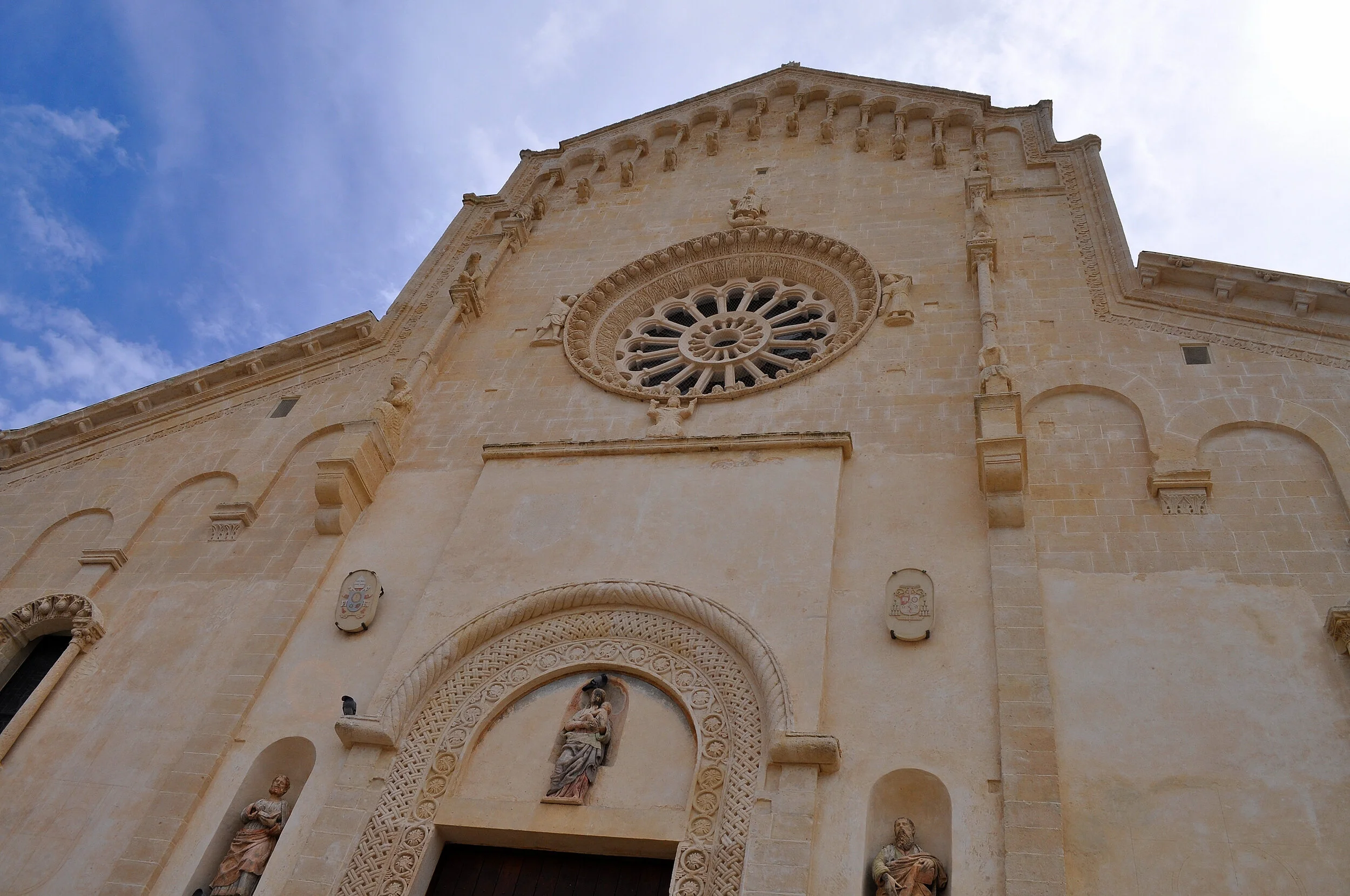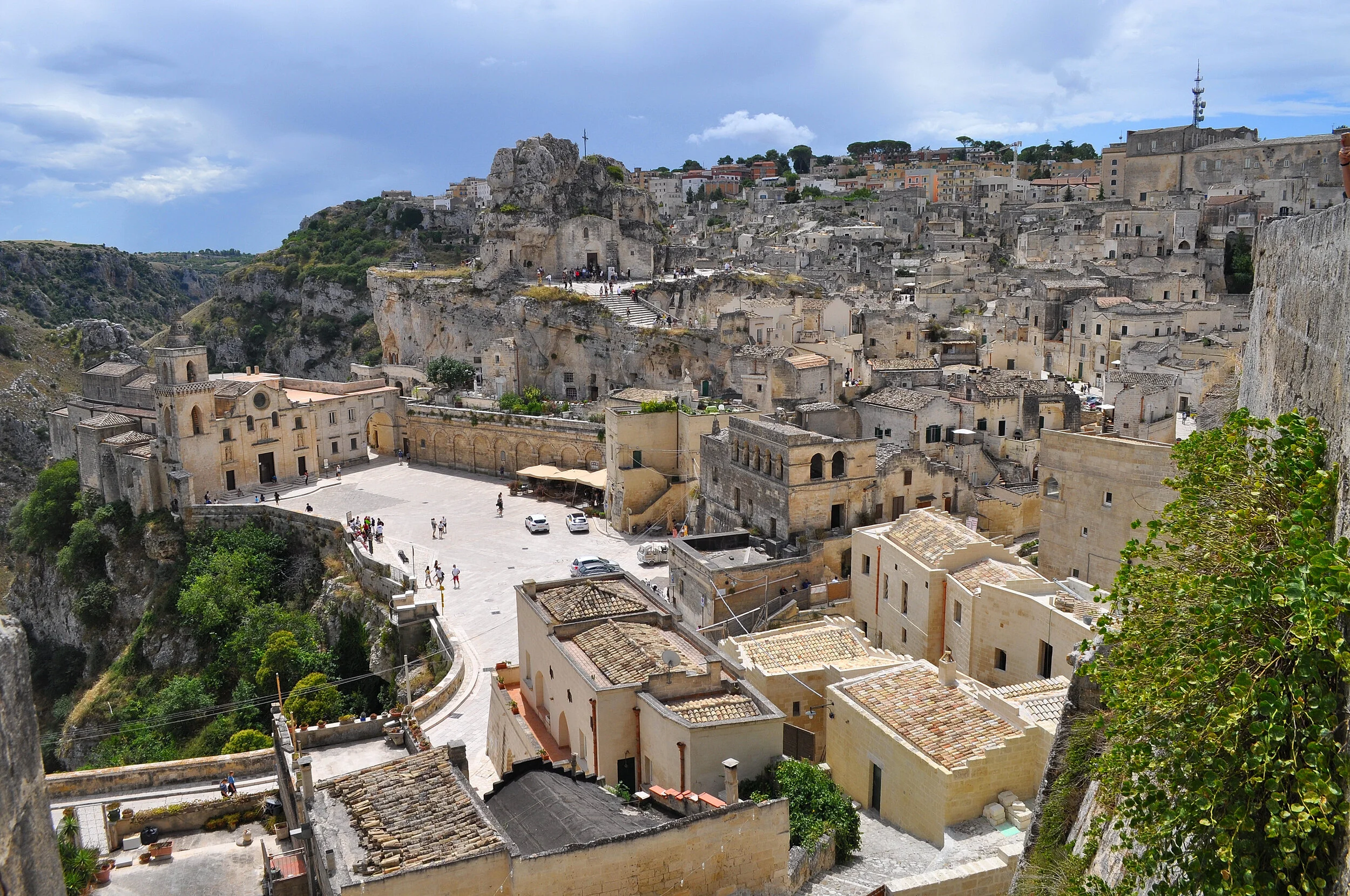Matera
Piero: during our Salento tour, we decide to treat ourselves to a special day in Basilicata.
Angela: our main destination is Matera, the city of the Sassi; then we’ll make a brief stop in Craco.
Piero: I’ve always been fascinated by images of Matera, and finally visiting it is like a dream come true! Click HERE to see all the photos and enjoy a preview of this wonder in the video!
Angela: it’s true! We’ll discover that no image can fully capture the feeling of being there in person and the wonder that will remain forever engraved in our memories.
Piero: Matera is one of the oldest cities in the world, considered by some as the third oldest after Aleppo and Jericho. It has been inhabited since the Paleolithic, and visiting it is like retracing human history from its origins.
Angela: time seems to have stopped here: man and nature have always perfectly blended, creating an extraordinary landscape, almost like a living nativity scene.
Piero: the Sassi districts, Caveoso and Barisano, are the two traditional quarters, now UNESCO World Heritage Sites—the first in southern Italy to receive this honor.
Angela: Matera is also a city of many hidden treasures, museums, festivals, and concerts. In 2019, it was the European Capital of Culture: an incredible redemption for a land often forgotten, once called “the shame of Italy” just fifty years ago.
Piero: We leave early in the morning from Porto Cesareo. The distance isn’t too long, and the road is fairly easy but busy. It will take about two hours to reach our destination.
Angela: To make the most of our time and not miss anything important, we decide to explore the city with the help of a guide.
Piero: There are plenty of guides available, both official and unofficial, many of which can also be arranged on site.
Angela: we chose Matera City Tour (materacitytour.it). they offer various tours and options; we booked the walking city tour directly online.
Piero: it's a comprehensive 1.5-hour walking tour through the heart of Matera, the Sassi, the rock churches, ending with a visit to a cave dwelling. suitable for everyone, including children and teens, and quite affordable.
Angela: the real added value is the official guide—mostly young students passionate and knowledgeable about the city, sharing their deep love for this land.
Piero: we met with a small group near the church of san francesco, starting promptly at 11 a.m.
Angela: our challenging walk began along via Duomo, heading toward the cathedral square.
Piero: we start to savor the evocative views of this maze of narrow streets and houses carved into the tuff rock.
Angela: we reach the Duomo, located at the highest point of the city, on the Civita hill. its bell tower, 52 meters tall, dominates the city skyline.
Piero: the square in front offers a beautiful view of the first of the two Sassi, the Barisano.
Angela: it faces perfectly west; unlike the interior, which has undergone many changes over time, the exterior almost entirely retains its original form. the façade is dominated by a sixteen-ray rose window.
Piero: after 2019, many of Matera’s buildings lost their dark, grayish hues caused by weathering and pollution thanks to a major cleaning effort that restored the tuff’s vibrant color visible today.
Angela: from the Duomo square, we begin our descent toward the second Sasso, the Caveoso, perhaps the most enchanting one.
Piero: the beauty of this city is that every step offers a fantastic view, to be remembered and, above all, immediately photographed.
Angela: just don’t do like Piero, who, stopping too often for his photos, got separated from the group and the guide... and finding your way in these alleys is really a challenge!
Piero: during the descent, we stop to admire the view of the church of San Pietro Caveoso and the rock church of Madonna dell’Idris, half carved into the rock and half built outside.
Angela: before reaching the square, we stop to visit a cave-house, probably the true essence of life in Matera before the depopulation of the 1960s began.
Piero: these houses, inhabited until the late 1950s, often by very large families, consist of a single space partly dug into the rock and partly built, furnished with period furniture and tools. There’s the hearth with the kitchen, the bed with a mattress filled with corn leaves, the chamber pot, the loom, the manger area for the mule, the cavity where manure was collected for heating, and the cistern where rainwater was channeled through a system of canals.
Angela: there are no windows: light and air entered only through the main entrance. Farming families lived there alongside animals: these were both homes and stables. On the table, the single bowl shows how everyone ate together from it.
Piero: the spaces in front of the houses were very important too, as they hosted essential interactions with neighbors—the only real support for those living in these homes.
Angela: nothing was wasted; everything was reused and repurposed: from rainwater collected with ingenious systems to manure used for heating, from leaves used for bedding to animal bones employed in construction.
Piero: it’s striking to think that until a few decades ago, over twenty thousand people lived under these conditions. the forced evacuation in the 1950s led to the gradual depopulation of the Sassi, which have since become the city’s main tourist attraction.
Angela: after visiting the cave-house, we explore another iconic Matera attraction: the rock-hewn church.
Piero: there are dozens of these churches, dating back to the early Middle Ages, when monks began settling in the Gravina caves, transforming them into places of worship.
Angela: architecturally unique, their decorations are exceptional works of art.
Piero: next, we reach the square in front of the church of San Pietro Caveoso.
Angela: from here, we admire the Gravina river flowing below, the hanging suspension bridge leading to the Murgia Materana park, and the canyon opposite.
Piero: our guided tour concludes with a return to the city center along a different route, winding through even narrower streets and passing over the rooftops of some houses—showing how homes and alleys form a complex, unified puzzle.
Angela: we reach Vittorio Veneto square to enjoy another stunning view of the Sasso Barisano.
Piero: it’s time to stop for lunch, tired and a bit wet from a sudden downpour!
Angela: we book a table at il cantuccio, a charming typical trattoria in Matera.
Piero: a small, carefully detailed restaurant where the owner guides you through local flavors.
Angela: we try some traditional specialties, accompanied by matera’s famous bread and dishes based on peperone crusco.
Piero: excellent meal with a great quality/price ratio — a must-try!
Angela: after lunch, we let the wives and kids rest in the car while we leave Matera heading toward Potenza.
Piero: we cross a fantastic stretch of lucanian land, sparsely inhabited, where we observe the calanchi — erosion gullies carved into hillsides.
Angela: after about an hour, we reach craco, the beautiful “ghost town” still in Matera province.
Piero: from afar, it looks more like a beautiful, evocative sculpture than a town.
Angela: nel 1963 è stato completamente abbandonato dalla popolazione a causa di una frana; un’alluvione dieci anni dopo ed il terremoto del 1980 hanno impedito la ricostruzione ed il ripopolamento.
Piero: oggi rimangono le case in pietra aggrappate alla roccia, con la torre normanna che spicca sulle altre costruzioni.
Angela: per evidenti motivi di sicurezza, non è possibile visitare il paese autonomamente, ma lo si può fare attraverso una visita guidata ed attrezzata da prenotare per tempo.
Angela: in 1963 the town was completely abandoned due to a landslide; a flood ten years later and the 1980 earthquake prevented any reconstruction or repopulation.
Piero: today, stone houses cling to the rock, with the Norman tower standing prominently above the other buildings.
Angela: for obvious safety reasons, independent visits are not allowed; tours must be booked in advance and are guided and equipped.

























